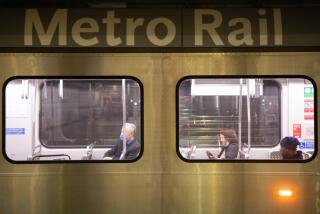Trial to begin in deadly 2005 Metrolink crash
- Share via
Juan Manuel Alvarez does not dispute that his actions led to the tragic Metrolink train collision three years ago in which 11 people were killed and more than 180 injured. What he does contest is that he intended to harm anybody other than himself.
The issue of whether the 29-year-old Compton man willfully set out to derail a train, commit arson, maim and kill people will be at the core of arguments that a jury of three men and nine women will begin to hear today as Alvarez’s trial gets underway.
If convicted of first-degree murder, Alvarez could face the death penalty.
On the morning of Jan. 26, 2005, Alvarez parked his Jeep Grand Cherokee on railroad tracks about half a mile south of downtown Glendale. He ran from the vehicle shortly before a southbound Metrolink commuter train slammed into it. The train derailed, struck a parked Union Pacific freight train and then collided with a northbound Metrolink passenger train.
It was the most devastating wreck in Metrolink history, authorities said.
Alvarez’s intent is important in a legal sense: If he meant to kill passengers on the train, he could be found guilty of first-degree murder. But even if jurors do not find that intent, Alvarez could be convicted of second-degree murder if it can be shown that his actions created a high probability of death, and that he knew of the risks associated with parking his vehicle on the tracks.
Attorney Thomas W. Kielty, who represents Alvarez, said his client’s tragic deed was a failed attempt at suicide. He said Alvarez changed his mind about killing himself and tried to remove his Jeep from the tracks, but the tires only spun into the gravel. At the last moment, he said, Alvarez jumped out of the way of the oncoming train. Alvarez never intended to hurt anybody, Kielty said.
“If Juan Alvarez’s intent was to commit suicide, then there is no question that he’s not guilty of the felonies,” Kielty said. “In a civil and moral sense it was his fault, and there’s no denying that. But there is no first-degree murder, because he did not intend to derail and burn the train.”
Kielty said that Alvarez, who he said has a history of mental illness and suicide attempts, would take the witness stand. At the time of the incident, Alvarez was depressed and having marital problems, his lawyer said.
Other witnesses, Kielty said, would be called to testify about Alvarez’s state of mind before and after the train crash.
One witness saw Alvarez fall to his knees and cry “hysterically” when he learned people had perished in the wreck, according to court papers filed by defense attorneys. Alvarez’s lawyers also say the defendant thought the oncoming train would be a freight train, not a passenger train.
During a recent court hearing, the judge in the case suggested that Alvarez’s kneeling outburst could have meant, “Yeah. Thank God it worked the way I planned.”
In the aftermath of the calamity, Kielty said, Alvarez was overwhelmed with regret and stabbed himself in the chest in yet another suicide attempt.
Kielty argues that Alvarez could not have foreseen the chain-reaction crash that would result from his parking on the tracks.
“He’s a mentally ill, flying-under-the-radar, street-level meth addict,” Kielty said. “He just wanted to kill himself.”
Sandi Gibbons, a spokeswoman for Los Angeles County Dist. Atty. Steve Cooley, declined to comment on the case, saying that “it would be improper for us to be making any out-of-court comments at this crucial time in the proceeding.”
Prosecutors, in court papers, have argued that evidence in the case refutes Alvarez’s claim of a suicide bid.
They alleged that he doused both the exterior and interior of his vehicle with gasoline, set the parking brake and left his vehicle on the tracks in front of the Metrolink train.
The intensity of the fire that resulted from the crash “consumed” the front of the train and hampered law enforcement officials from assisting people who were screaming for help, according to the testimony of one law enforcement officer.
Another officer said the hand brake recovered from the wrecked vehicle had been “engaged in the up position,” a fact prosecutors say disproves Alvarez’s claims that he tried to move his car before the train struck.
In a parallel civil case, 61 victims are suing Metrolink and the Los Angeles County Metropolitan Transportation Authority for liability. Their case includes arguments that safety measures, such as a gate, would have prevented Alvarez from getting onto the tracks; and that a controversial “push-pull” system for operating trains enhanced the risk of death and injury to the passengers.
J. Clark Aristei, plaintiffs’ liaison counsel for the Plaintiffs’ Steering Committee, a team of lawyers representing people who have filed personal injury and wrongful-death cases, expressed concern that the criminal trial might fail to adequately resolve key questions that are at the core of the civil case. These include how the tragedy happened, what caused it, who’s responsible and how it could have been prevented.
As a result, the conclusion could be drawn that “whatever happens in the criminal case is it, so why are we having a civil trial?” Aristei said. The civil trial is scheduled to begin in August.
Aristei said his clients’ feelings about Alvarez span “the full range of human emotions” from “forgiving Mr. Alvarez, to wanting to see him suffer the maximum penalty.”
--
--
Times staff writer Victoria Kim contributed to this report.
More to Read
Sign up for Essential California
The most important California stories and recommendations in your inbox every morning.
You may occasionally receive promotional content from the Los Angeles Times.














